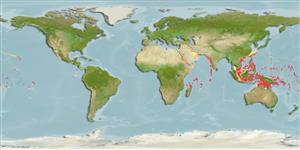>
Eupercaria/misc (Various families in series Eupercaria) >
Labridae (Wrasses) > Cheilininae
Etymology: Oxycheilinus: Greek, oxys = sharp + Greek, cheilos = lip.
More on author: Günther.
Environment: milieu / climate zone / depth range / distribution range
экология
морской ассоциированный с рифами; пределы глубины 0 - 80 m (Ref. 9823). Tropical; 30°N - 15°S
Indo-West Pacific: Red Sea, Indonesia to Ryukyu Is., Marshall Is.
Size / Вес / Возраст
Maturity: Lm ? range ? - ? cm
Max length : 20.0 cm TL самец/пол неопределен; (Ref. 48636)
колючие лучи спинного плавника (общее число) : 9; членистые (мягкие) лучи спинного плавника (общее число) : 10; колючие лучи анального плавника: 3; членистые (мягкие) лучи анального плавника: 8; позвонки: 23. Color of large adults red in life; body usually with 5 indistinct narrow pale bars that may contain white flecks, and 2 faint pale stripes along side; irregular bright red vertical lines on edges of scales anteriorly on midside and lower part of body, along with red dots; head with white to pale blue-green transverse lines on side of lower jaw, widest near front of chin; side of snout and head below eye with small dark-edged white to pale blue-green spots; iris orange-yellow with a blue ring, hind edge of eye black with a bright blue-green spot above (shows when eye directed forward); a blackish smudge on 2nd and 3rd lateral-line scales may be present (not related to sex); dorsal and anal fins light orange-red with oblique red lines and dark-edged white to blue lines or rows of dashes or small spots, the dorsal sometimes blackish on 1st membrane, rarely with a broad dusky border; caudal fin red with small white spots, often with an irregular blotchy white bar near base; pectoral fins with dark-edged pale yellowish rays and clear membranes; pelvic fins translucent whitish, blotched with red and flecked with white. Color of small adults light red, finely flecked with pink dorsally and white ventrally, with an orange-yellow stripe from chin to eye and along side of body to midbase of caudal fin; stripe on body broadly bordered above and below with a broad whitish band; edges of scales along midside of body with vertical red lines; two small midlateral bright red spots, one below middle of soft portion of dorsal fin and the other on base of caudal fin (Ref. 47566).
Found in coastal to outer reef habitats; juveniles often in crinoids or soft corals at moderate depths (Ref. 48636). Probably occurring deeper than normal diving depths (Ref. 35918). Reported to be associated with the mushroom Heliofungia actiniformis (Ref. 91291). Occurs among dense cover of coral rubble or algae. Feeds mainly on fishes, shrimps and other crustaceans. Known in outer reef lagoons to deep slopes with other invertebrates (Ref. 9002). Females swim in small groups (Ref. 48636). Minimum depth reported taken from Ref. 128797.
Life cycle and mating behavior
Maturities | размножение | Spawnings | Egg(s) | Fecundities | личинки
Oviparous, distinct pairing during breeding (Ref. 205).
Westneat, M.W., 2001. Labridae. Wrasses, hogfishes, razorfishes, corises, tuskfishes. p. 3381-3467. In K.E. Carpenter and V. Niem (eds.) FAO species identification guide for fishery purposes. The living marine resources of the Western Central Pacific. Vol. 6. Bony fishes part 4 (Labridae to Latimeriidae), estuarine crocodiles. FAO, Rome. (Ref. 9823)
Статус Красного Списка МСОП (Ref. 130435)
Угроза для людей
Harmless
Использование человеком
рыболовство: не имеет хозяйственного значения; аквариум: коммерческий
дополнительная информация
инструменты
Специальные отчеты
Скачать в формате XML
ресурсы в Интернет
Estimates based on models
Preferred temperature (Ref.
123201): 25 - 28.9, mean 27.9 °C (based on 362 cells).
Phylogenetic diversity index (Ref.
82804): PD
50 = 0.5020 [Uniqueness, from 0.5 = low to 2.0 = high].
Bayesian length-weight: a=0.01585 (0.00707 - 0.03555), b=2.95 (2.76 - 3.14), in cm total length, based on LWR estimates for this (Sub)family-body shape (Ref.
93245).
Trophic level (Ref.
69278): 3.8 ±0.62 se; based on food items.
устойчивость к внешним воздействиям (Ref.
120179): средний (среднего размера), минимальное время удвоения популяции 1.4-4.4 года (Preliminary K or Fecundity.).
Fishing Vulnerability (Ref.
59153): Low vulnerability (10 of 100).
Nutrients (Ref.
124155): Calcium = 70.9 [25.6, 161.5] mg/100g; Iron = 0.799 [0.294, 1.861] mg/100g; Protein = 18.6 [15.7, 20.8] %; Omega3 = 0.166 [0.084, 0.325] g/100g; Selenium = 31.4 [11.3, 94.6] μg/100g; VitaminA = 137 [42, 516] μg/100g; Zinc = 1.96 [0.85, 3.42] mg/100g (wet weight);
